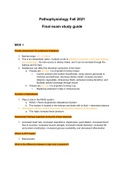Pathophysiology Fall 2021
Final exam study guide
MOD 1
Priority assessment for potassium imbalance
1. Normal range: 3.5 – 5 mEq/L
2. This is an intracellular cation. It places a role in electrical conduction, acid-base balance,
and metabolism. Its main source is dietary intake, and it can be excreted through the
kidneys and GI tract.
3. Imbalances can affect the electrical conduction of the heart
a. If levels are too high, it is important to bring it down
i. Correct acidosis with sodium bicarbonate, using calcium gluconate to
minimize dysrhythmias, decrease dietary intake, increase excretion
(dialysis, kayexalate, intravenous fluids, potassium-losing diuretics), and
facilitate cellular exchange through insulin.
b. If levels are too low, it is important to bring it up
i. Replacing potassium orally or intravenously
Function of aldosterone
1. Plays a role in the RAAS system
a. RAAS = Renin-Angiotensin-Aldosterone System
b. This system is located in the kidneys and deals with its fluid + electrolyte balance
2. Aldosterone attracts sodium and water, causing fluid retention in the kidneys
a. This helps increase blood pressure
Assessment findings expected during the stress response
1. Increased heart rate, increased respirations, diaphoresis, pupil dilation, increased blood
flow to muscles, increased muscle strength, increased mental alertness, increased fat
and protein mobilization, increased glucose availability, and decreased inflammation
Where is ATP made?
1. Mitochondria
What is the difference between a sign and a symptom?
, 1. Sign – Objective, things that the provider observes
2. Symptom - Subjective, things that the patient experience
What is the purpose of the stress response?
1. Flight-or flight response activated by sympathetic and endocrine system
2. (online) a method to keep the body safe in certain situations/emergencies
Effects of the release of catecholamines during the stress response
1. Catecholamines - dopamine, epinephrine and norepinephrine
2. Released to regulate the flight-or-fight response
a. Epinephrine is released during sympathetic response
b. Norepinephrine is released during parasympathetic response
c.
,Review the main electrolytes discussed. Na, K, Mg, Ca, Ph. Review where they are found along
with the main clinical manifestations we discussed
1. Sodium (Na)
a. Normal range: 135-135 mEq/L
b. Location: Extracellular fluid
c. Function: controls serum osmolarity + water balance. Plays a role in acid-base
balance. Facilitates muscles + nerve impulses
d. CM of hypernatremia
i. Increased temperature, warm and flushed skin, dry and sticky mucous
membrane, dysphagia, increased thirst, irritability, agitation, weakness,
headache, seizures, lethargy, coma, blood pressure changes,
tachycardia, weak and thready pulse, edema, decreased urine output
e. CM of hyponatremia
i. Anorexia, upset GI, poor skin turgor, dry mucous membranes, blood
pressure changes, pulse changes, edema, headache, lethargy, confusion,
diminished deep tendon reflexes, muscle weakness, seizures, coma
2. Potassium (K)
a. Normal range: 3.5-5 mEq/L
b. Location: Intracellular fluid
c. Function: electrical conduction, acid-base balance, metabolism
d. CM of Hyperkalemia
i. Paresthesia, muscle weakness, flaccid paralysis, bradycardia,
dysrhythmias, electrocardiogram changes, cardiac arrest, respiratory
depression, abdominal cramping, nausea, diarrhea
e. CM of Hypokalemia
i. Muscle weakness, paresthesia, hyporeflexia, leg cramps, weak and
irregular pulse, hypotension, dysrhythmias, electrocardiogram changes,
decreased bowel sounds, abdominal distension, constipation, ilues, and
cardiac arrest
3. Magnesium (Mg)
a. Normal range: 1.8-2.5 mEq/L
b. Location: Intracellular fluid; stored in bone + muscle
c. Function: muscle and nerve function, cardiac rhythm, immune function, bone
strength, blood glucose management, blood pressure, energy metabolism,
protein synthesis
d. CM of Hypermagnesemia
i. Similar to hypercalcemia
e. CM of Hypomagnesemia
i. Similar to hypocalcemia
4. Calcium (Ca)
a. Normal range: 4-5 mEq/L
b. Location: in bone/teeth
, c. Function: blood clotting, hormone secretion, receptor functions, nerve
transmission, muscular contraction
i. INVERSE relationship with phosphorus
ii. SYNERGISTIC relationship with magnesium
d. CM of Hypercalcemia
i. Dysrhythmias, electrocardiogram changes, personality changes,
confusion, decreased memory, headache, lethargy, stupor, coma, muscle
weakness, decreased deep tendon reflexes, anorexia, nausea, vomiting,
constipation, abdominal pain, pancreatitis, renal calculi, polyuria,
dehydration
e. CM of Hypocalcemia
i. Dysrhythmias, electrocardiogram changes, increased bleeding
tendencies, confusion, anxiety, depression, irritability, fatigue, lethargy,
paresthesia, increased tendon reflexes, tremors, muscle spasms,
seizures, laryngeal spasms, increased bowel sounds, abdominal
cramping, positive Trousseau’s and Chvostek’s signs
5. Phosphorus (Ph)
a. Normal range: 2.5-4.5 mg/dL
b. Location: bone
c. Function: bone + tooth mineralization, cellular metabolism, acid-base balance,
cell membrane formation
d. CM of Hyperphosphatemia
i. Rare
e. CM of Hypophosphatemia
i. Similar to hypercalcemia
What is homeostasis?
1. Maintains electrolytes so that cellular functions and blood volume remains normal
a. Self-regulating
b. Compensatory
c. Negative feedback (most common) vs. Positive feedback
2. Uses many means to correct one imbalance
Function of ribosomes
1. Aid in protein production on the RER and polysomes




